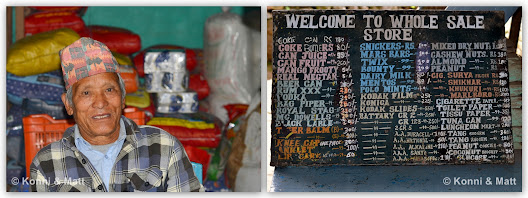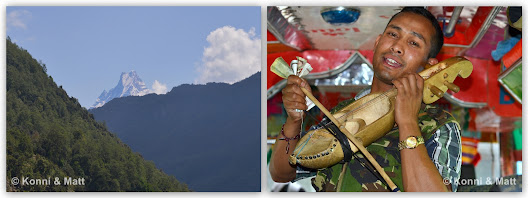Pachyderms in Nepal…
“We make a lot of detours, but we're always heading for the same destination.”
Matt: Making a detour between Pokhara, the starting point for my recent Annapurna Sanctuary Trek [1], and Kathmandu [2], [3], Nepal's only international airport, and coming en-route in contact with awesome Indian elephants and Indian unicorns.
“We make a lot of detours, but we're always heading for the same destination.”
(Paulo Coelho)
Matt: Exploring the sprawling village of Sauraha, an overpriced tourist trap with many, mostly female, Asian working elephants which are used on safaris that look for tigers and rhinos and take tourists, who ride on a wooden platform aka howdah which is tied to the backs of the elephants (the elephant driver aka mahout sits on the elephant's neck and guides the animal by nudging a sensitive area behind her ears with a stick) into the jungle, and enjoying in the evening fantastic beer-enhanced sunsets over the sluggish Rapti River.
Matt: Visiting the local Elephant Breeding Centre (admission: NPR 50.- per foreigner), c. 3 km west of Sauraha on the far side of the small Bhude Rapti River, which provides many of the elephants for elephant safaris into the Royal Chitwan National Park, and watching the interaction between mother and baby elephants, as well as the multitask use of their trunk (which has a staggering 40,000 muscles), such as covering themselves in dust to ward off mosquitoes or scratching their backside with a bamboo stick.
Matt: Taking a rolling ride on an elephant's back (charges: NPR 1,500.- or US$ 15.- per passenger, plus the steep entrance fee to the Royal Chitwan National Park of NPR 1,695.- or US$ 17.- per foreigner), lumbering through the dense jungle with this five-tonne jumbo, feeling her raised spine and the rumbling movement of her shoulder blades for more than two hours, feeding her bananas now and then and spotting from this fantastic viewing point high above the shrubs and tall grass a thick-skinned, one-horned Indian rhinoceros (Rhinoceros unicornis).
Matt: Taking an expensive and comfortable a/c tourist bus from Sauraha's tourist bus park to quake-hit Kathmandu (c. 160 km, 6 hours, NPR 500.- or US$ 5.- per tourist).
Matt: Saying my good-byes to Kathmandu, which has been severely hit by two recent earthquakes (the 7.8-magnitude April 2015 Nepal Earthquake and the 7.3-magnitude May 2015 Nepal Earthquake) and has changed a lot since my previous visit in autumn 2014 ([1], [2]), and having a memorable farewell party with a bunch of local operatives in our favourite shebeen aka bhojanalaya in nearby Thahity: excellent Newari raksi/aylā and, for me only, the vegan version of delicious samay baji; thanks, namaste and subhakamana, my trusted friends.
Matt: Requesting a vegan meal for my upcoming long-distance flight back to Canada and learning about the fact that most full-service airlines do offer five different perfectly vegan food options: (i) VGML (Vegetarian/Vegan Meal - which is totally free of any animal products or by-products such as eggs or dairy products; it contains all types of vegetables and fresh fruit; it does not contain any type of meat, fish, or animal products or by-products), (ii) VOML (Vegetarian/Vegan Oriental Meal - which is a Vegetarian/Vegan Meal [VGML] that is also prepared Chinese or Oriental-style), (iii) VJML (Vegetarian/Vegan Jain Meal - which is for members of the Jain community who are pure vegetarians; it is prepared with a selection of Indian condiments and contains fresh fruit and cooked stem vegetables that grow above the ground; it does not contain animal products, by-products and any root vegetables such as onions, mushrooms, ginger, garlic, potatoes, carrots, beets, radishes, etc.), (iv) RVML (Raw Vegetable Meal - which consists exclusively of raw vegetables and salads), (v) FPML (Fruit Platter Meal - which may be ordered for dietary reasons and/or by members of certain communities who eat only fruit while fasting; it contains seasonal fresh fruit); it's all up and down to you…
Matt: Requesting a vegan meal for my upcoming long-distance flight back to Canada and learning about the fact that most full-service airlines do offer five different perfectly vegan food options: (i) VGML (Vegetarian/Vegan Meal - which is totally free of any animal products or by-products such as eggs or dairy products; it contains all types of vegetables and fresh fruit; it does not contain any type of meat, fish, or animal products or by-products), (ii) VOML (Vegetarian/Vegan Oriental Meal - which is a Vegetarian/Vegan Meal [VGML] that is also prepared Chinese or Oriental-style), (iii) VJML (Vegetarian/Vegan Jain Meal - which is for members of the Jain community who are pure vegetarians; it is prepared with a selection of Indian condiments and contains fresh fruit and cooked stem vegetables that grow above the ground; it does not contain animal products, by-products and any root vegetables such as onions, mushrooms, ginger, garlic, potatoes, carrots, beets, radishes, etc.), (iv) RVML (Raw Vegetable Meal - which consists exclusively of raw vegetables and salads), (v) FPML (Fruit Platter Meal - which may be ordered for dietary reasons and/or by members of certain communities who eat only fruit while fasting; it contains seasonal fresh fruit); it's all up and down to you…
Matt: Taking a reliable city bus from Kathmandu's Old City Bus Park to the extremely busy Tribhuvan International Airport (c. 5 km, ½ hour, NPR 20.- per person), flying with top-notch Etihad Airways (“The World Is Our Home, You Are Our Guests”, delicious vegan meals) in a clean Airbus A 320-200 from Kathmandu to Abu Dhabi International (Terminal 1), thereafter from Abu Dhabi International (Terminal 3) in a big and comfy Airbus A 330 to Brussels and doing eventually the last leg from Brussels with Jet Airways ("The Joy of Flying") in a worn Airbus A 330-300 over the Atlantic Ocean to Toronto Pearson International, for US$ 1,275.- per person for the complete return/jaw half-around-the-world ticket Kathmandu-Toronto-Bangkok, all inclusive and booked over the internet already in November 2014 CE with Airline Direct, and arriving in South Ontario for my annual summer break together with Konni and my awesome bilingual grandchildren Raoni, Tien and Ronja, eh!
"The lemon trees blossom,
The almond trees wither,
It’s Spring and it’s Summer,
And it’s Winter forever,
Did I ever love you,
Does it really matter..."
(Leonard Cohen)
Auf meiner Reise von Pokhara nach Kathmandu habe ich einen Umweg ueber den Chitwan Nationalpark gemacht. Dieser liegt im Grenzland zwischen Nepal und Indien und ist dafuer bekannt, dass man auf einem abgerichteten Elefanten reiten kann, um wilde Tiere aus sicherer Hoehe zu beobachten: Hirsche, Panzernashoerner und manchmal auch einen Bengalischen Tiger.
Vorn, gleich hinter den Ohren des Elefanten, sitzt der Elefantenfuehrer, der mahut, und lenkt den dicken Elefanten mit seinen nackten Fuessen und durch laute Befehle in der Elefantensprache. Der mahut und sein Elefant leben viele Jahre zusammen, wie eine kleine Familie, und beide verstehen sich recht gut. Vor der Safari wird ein Sattel fuer die Passagiere auf den Ruecken des Elefanten gebunden und los geht es im schaukelnden Elefantentrott. Die Landratten unter den Passagieren werden dabei manchmal sogar seekrank…
Auf dem Ruecken des Elefanten hatte ich Zeit, darueber nachzudenken, worauf ich in meinem Leben bereits geritten bin: frueher beim Militaer und auch nach meiner Versetzung in den Ruhestand am liebsten auf Motorraedern [1] und ab und an auch auf kernigen Drahteseln, einige Male auch auf Pferden und Dromedaren [2], als kleiner Junge sogar einmal auf einem richtigen Esel…
Vorn, gleich hinter den Ohren des Elefanten, sitzt der Elefantenfuehrer, der mahut, und lenkt den dicken Elefanten mit seinen nackten Fuessen und durch laute Befehle in der Elefantensprache. Der mahut und sein Elefant leben viele Jahre zusammen, wie eine kleine Familie, und beide verstehen sich recht gut. Vor der Safari wird ein Sattel fuer die Passagiere auf den Ruecken des Elefanten gebunden und los geht es im schaukelnden Elefantentrott. Die Landratten unter den Passagieren werden dabei manchmal sogar seekrank…
Auf dem Ruecken des Elefanten hatte ich Zeit, darueber nachzudenken, worauf ich in meinem Leben bereits geritten bin: frueher beim Militaer und auch nach meiner Versetzung in den Ruhestand am liebsten auf Motorraedern [1] und ab und an auch auf kernigen Drahteseln, einige Male auch auf Pferden und Dromedaren [2], als kleiner Junge sogar einmal auf einem richtigen Esel…
Dabei gibt es auf dieser Welt noch viele andere Reittiere: Lamas, Trampeltiere, Maultiere, Maulesel, Rentiere, Yaks und Wasserbueffel [3]. Strausse dienen vor allem in Suedafrika's Eastern Cape Province als Reittiere zur Touristen-Attraktion und das Reiten auf Bullen ist ein beliebter Wettbewerb innerhalb von Rodeos bei Euren suedlichen Nachbarn.
Ob Fred Feuerstein nun wirklich auf einem Dinosaurier durch das Neanderthal, Arion von Korinth auf einem Delphin oder sogar einem Seepferd durchs Mittelmeer und Nils Holgersson auf einer Wildgans ueber Schweden hinweggeritten sind, das alles solltet Ihr besser selber herausfinden. - Worauf werdet Ihr wohl als naechstes reiten?
From Nepal, with Love!
Ob Fred Feuerstein nun wirklich auf einem Dinosaurier durch das Neanderthal, Arion von Korinth auf einem Delphin oder sogar einem Seepferd durchs Mittelmeer und Nils Holgersson auf einer Wildgans ueber Schweden hinweggeritten sind, das alles solltet Ihr besser selber herausfinden. - Worauf werdet Ihr wohl als naechstes reiten?
From Nepal, with Love!
Click below for more blog posts about Asian/Indian elephants
23 Feb - 02 Mar 2015 Jodhpur
12 May - 18 May 2011 Hampi
12 Apr - 23 Apr 2011 Madurai
16 Feb - 17 Feb 2011 Colombo
03 Feb - 05 Feb 2011 Tissamaharama
22 Feb - 24 Feb 2010 Chiang Dao
27 Oct - 29 Oct 2009 Bilit
23 Feb - 02 Mar 2015 Jodhpur
12 May - 18 May 2011 Hampi
12 Apr - 23 Apr 2011 Madurai
16 Feb - 17 Feb 2011 Colombo
03 Feb - 05 Feb 2011 Tissamaharama
22 Feb - 24 Feb 2010 Chiang Dao
27 Oct - 29 Oct 2009 Bilit


























































